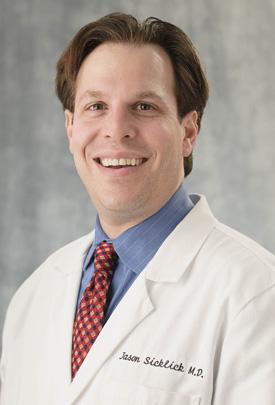New at-risk group identified for gastrointestinal stromal tumors

This is Jason Sicklick, MD, a surgical oncologist who works for the UC San Diego Health System. Credit: UC San Diego School of Medicine
One key finding: Patients of Asian descent, who have not previously been identified as an at-risk population, are 1.5 times more likely than other patient groups to be diagnosed with this type of tumor. Results of the study were published this week in Cancer Epidemiology, Biomarkers & Prevention, a journal of the American Association for Cancer Research.
“Previous journal articles never clearly differentiated GIST from several other tumors, even though they have different biologies,” said Jason Sicklick, MD, assistant professor of surgery and a surgical oncologist at UC San Diego Health System. “This study more clearly identifies at-risk populations in the United States as well as incidence rates, survival trends and risk factors for the disease.”
Prior to 2001, GIST-specific histology codes were not used in medical coding, which meant that a variety of tumor types, such as leiomyoma and leiomyosarcoma, spindle cell, myofibroblastic, desmoid and KIT-positive metastatic melanomas were all lumped into one category. Sicklick and his team have used a new generation of precise pathologic diagnostic codes to better define the incidence and distribution of GIST among different patient groups.
The research team from UC San Diego Moores Cancer Center found that the overall incidence rate was 6.8 cases per million people and that the rate rose from 2001 to 2011. During the study period, the median age of GIST diagnosis was 64 years old. GISTs were more common in men.
“Contradicting prior reports we see a definite survival disparity, particularly among patients of African-American descent,” said Sicklick.
Persons of African-American or Asian/Pacific Islander descent were 2.1 and 1.5 times more likely to develop GIST than Caucasians, respectively.
“Further studies are needed to understand why these groups are at-risk as it could carry important diagnostic, prognostic and therapeutic implications throughout the United States,” said James Murphy, MD, assistant professor of radiation oncology at UC San Diego School of Medicine and a radiation oncologist at UC San Diego Health System.
###
This study was funded by the National Institute of Health (KL2 RR031978) and the GIST Research Fund.
Contributors to this paper include: Grace L. Ma, and Maria E. Martinez, UC San Diego Moores Cancer Center.
Media Contact
All latest news from the category: Health and Medicine
This subject area encompasses research and studies in the field of human medicine.
Among the wide-ranging list of topics covered here are anesthesiology, anatomy, surgery, human genetics, hygiene and environmental medicine, internal medicine, neurology, pharmacology, physiology, urology and dental medicine.
Newest articles

Superradiant atoms could push the boundaries of how precisely time can be measured
Superradiant atoms can help us measure time more precisely than ever. In a new study, researchers from the University of Copenhagen present a new method for measuring the time interval,…

Ion thermoelectric conversion devices for near room temperature
The electrode sheet of the thermoelectric device consists of ionic hydrogel, which is sandwiched between the electrodes to form, and the Prussian blue on the electrode undergoes a redox reaction…

Zap Energy achieves 37-million-degree temperatures in a compact device
New publication reports record electron temperatures for a small-scale, sheared-flow-stabilized Z-pinch fusion device. In the nine decades since humans first produced fusion reactions, only a few fusion technologies have demonstrated…





















